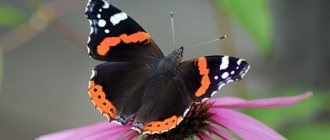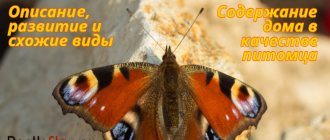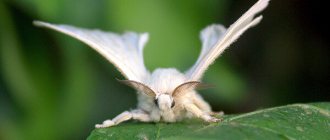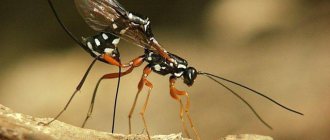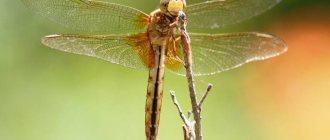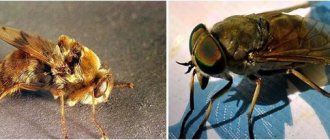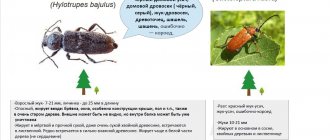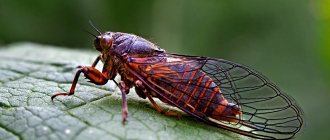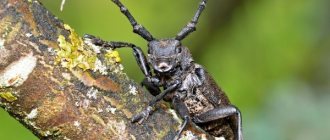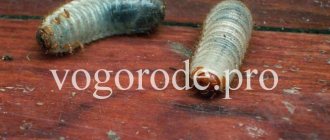general description
The wren is a diurnal nymphalid butterfly and the closest relative of the admiral. Its name is explained extremely simply - it was the nettle leaves that became the favorite refuge and basis of the caterpillars’ diet. Interestingly, unlike many butterflies, the wren sees the color red, which helps it navigate in search of food.
The Latin name for urticaria is Aglais, after the ancient Greek goddess Aglaia, the goddess of grace. There is also the spotted wren, but they are actually different moths. True, in appearance they differ only in one large spot on the front wings.
Hives live for about 9 months, which is a long time for moths. Depending on the climatic characteristics of the region, up to two generations are replaced in a calendar year. They fly from early spring days until September.
Photo: tr.science19.com
How does urticaria survive winter?
The urticaria butterfly does not die with the onset of cold weather. In early autumn, as soon as it gets cool, she looks for tree hollows or cracks in them. This becomes her shelter from cold nights, as well as her “home” during the winter. During the day, while the autumn sun is still warm, the hives fly out.
But at the end of autumn the days are getting colder. And as soon as the temperature becomes too low for the butterflies, they hibernate. In winter, urticaria freeze through, turning into ice shards, but do not die. As soon as the first rays of the warm spring sun begin to warm up, butterflies emerge from hibernation. But in early spring, it is not easy for the awakened “chocolate girls” to maintain their existence, since there is still very little food for them. There are also few nettles, so the conditions for propagation are unsuitable, and you have to wait for some time.
Urticaria live for about nine months and are classified as “wintering butterflies.” As mentioned above, they are born in the summer. Then, until winter, they feed and go into hibernation. In the spring, after the nettles have grown, they lay eggs on the leaves of this grass, and this ends the life cycle of nettle butterflies.
Appearance of butterflies
Wrens are butterflies with a wingspan of up to 62 mm. The lateral edge of all wings is wavy, with sharp projections. The main shade is brick red, with black, yellow and white spots. A characteristic feature that distinguishes urticaria from its relatives is a blue pattern along the edge.
The inside of the wings is brown, but not a solid color. Up close, complex patterns and color transitions are visible, and they are as unique as a person's fingerprints. The abdomen is brown, the antennae are club-shaped, and the front legs are small and are not needed for movement - only for landing. Hives caterpillars are dark or completely black, with yellow stripes on the sides and back.
Photo: butterfly-conservation.org
Interesting Facts
Butterfly hives, why is it called that? The name of the species in Russian and Latin (Nymphalisurticae) is associated with the food plant of the larvae - nettle. Adults are often seen fluttering above the bushes of the plant during oviposition. The close connection between the butterfly and nettle was the reason for choosing the name.
By observing the behavior of hives, you can predict the weather. If on a clear day a butterfly rushes about in search of shelter, it means that in a few hours it will rain heavily.
How many legs does a hives butterfly have? Lepidopteran insects have three pairs of legs attached to the chest. The family of nymphalids, to which the urticaria belongs, has a characteristic feature. The front legs of moths are reduced. They are greatly shortened and are not used when walking. The limbs are devoid of claws. The modified legs are covered with long bristles that serve as organs of touch. Butterflies move on two pairs of legs - middle and hind. But the limbs are used for moving short distances, as well as landing and taking off.
Types of urticaria
There are several subspecies of urticaria, which differ mainly only in the region where they occur. These are Caucasian, Amur, Vietnamese, Transbaikal, and European butterflies. But the opinions of scientists differ, and they cannot be clearly divided into a specific species classification.
Photo: crosti.ru
Admiral butterfly (60 photos): description, species and habitat
Literature
- Joseph Mocha Butterflies. - Prague: Artia, 1979. - P. 124. - 191 p.
- Kurentsov A. I. Club-bearded Lepidoptera of the Far East of the USSR. (Determinant). - L.: Nauka, 1970. - P. 26. - 163 p.
- Lvovsky A. L. 23. Sem. Nymphalidae - Nymphalidae // Insects and mites - pests of agricultural crops. Volume III. Lepidoptera. Part 2 / Ed. Kuznetsova V.I.. - St. Petersburg: Nauka, 1999. - 216 p.
- Morgun D. V. Club-bearded lepidoptera of European Russia and neighboring countries. Determinant-directory. - M.: MGSYUN, 2002. - P. 118. - 208 p.
- Nekrutenko Yu. P. Club-bearded Lepidoptera of Crimea. Determinant. - Kyiv: Naukova Dumka, 1985. - P. 85-86. — 152 s.
Lifestyle
Urticaria butterflies are truly ubiquitous, and due to this they easily adapt to different living conditions. Therefore, it is difficult to derive any general pattern of their behavior, but something can still be noted.
Habitats
Urticaria is common throughout Europe and Asia, except perhaps the Far North. They are found in the Caucasus, Kazakhstan, Yakutia and Kamchatka. They were found even in the Alps and Himalayas, at an altitude of over 5000 m.
Photo: premier-agro.ru
Diet
Urticaria butterflies feed mainly on flower nectar, which they suck out with a long proboscis. They also like thistle, dandelion, blackberry and marjoram. They love falling and even rotten fruits. And the caterpillars actively feed on different types of nettles, including stinging and stinging nettles.
Photo: krasivosti.pro
Humidity
Humidity is very important for hives. When drought occurs, the number of butterflies decreases significantly. In addition, this affects the future generation, because the lack of nutrients in the leaves leads to the caterpillars developing slowly and poorly.
Photo: pixabay.com
Wintering
Hives do not fly away and overwinter under bark, in hollows, basements, caves and other shelters. They fold their wings and in this form look like a dried leaf. To survive hibernation, butterflies actively feed and accumulate fat in the fall. They are not afraid of frost and can freeze completely at -20, but in the spring they will thaw and wake up.
Photo: kleo.ru
Development
The crop that the urticaria caterpillars feed on is also their home. Pests live in families and rarely spread out. After the time comes for pupation, they place their pupae directly on the same plants.
Hives caterpillar
There are 2 periods when the urticaria caterpillar appears. The first generation hatches in late spring early summer. This is May-June.
Important!
In southern latitudes, during the warm period, 2-3 generations of urticaria caterpillars manage to grow.
The second generation is born in July-August. Adult butterflies go to winter and hide in hollows and under the bark of trees. Only fertilized individuals survive the cold. The butterfly may even freeze through, but this will not kill it. With the onset of warmth, she will return to life again.
The caterpillar of the nettle butterfly is not afraid of stinging nettles and actively occupies it for its place of residence. During the period of growing up, she goes through several stages of molting. After each one it increases in size. In 30 days, it can grow up to 5 cm. The transformation time from a pupa to an adult is a couple of weeks.
Black caterpillars on nettles can be found in parks, meadows, near summer cottages and private houses. They also often choose valleys and mountainous areas as their habitat. If a nettle leaf is covered with a large number of black caterpillars, it means that these are urticaria and after 2-3 weeks you will be able to see very beautiful butterflies.
Rating( 1 rating, average 5 out of 5 )
Reproduction of urticaria
Urticaria most often reproduce in nettles. The female leaves up to 200 eggs on one leaf, and this takes up to 1.5 hours. Depending on the weather, the eggs turn into caterpillars in up to 3 weeks. Then the caterpillars continue to stick together as a whole brood, weave a common web, feed together and move from bush to bush.
The caterpillar molts 4 times and gradually turns black from green. Only after this do they spread out in search of a place for pupation and attach to branches and stems. The pupal stage takes about 2 more weeks, after which the adult butterfly hatches.
Photo: iassets.ru
Finch (50 photos): description of the bird, habitat and what it eats
Urticaria butterflies in captivity
Hives can be kept at home, and moreover, sometimes this is the only way to save caterpillars from frost if they wake up ahead of time at the end of winter. You need warmth, high humidity, fresh air and the right diet. Birch sap and honey solution will do. The butterfly needs to be fed once every 24-36 hours, depending on its activity.
Photo: ribalych.ru
Population and species status
Fortunately, the species is not listed in the Red Book, so there is no need to protect it. Urticaria is definitely not in danger of disappearing in the coming years. Thanks to the ability to adapt to any living conditions, butterflies reproduce well and their habitat is very wide. You can't meet them except at the North Pole.
Since the species does not cause any harm to agriculture, there have never been any attempts to exterminate chocolate makers. No country sees butterflies as negative images. Individuals exist in sufficient numbers everywhere, do not need protection, and according to scientists, the species will not become extinct in the next 20 years.
Record high air temperatures in recent years, according to researchers, have led to a high increase in the number of moths. Weather conditions have recently been ideal for the existence and reproduction of these beautiful creatures.
During 2010-2011, the number of chocolate makers increased by 60%. But during the period when the summer was quite cold, the population again decreased significantly. Scientist from the Center for Ecology Mark Botham emphasized that it is necessary to locally maintain a favorable environment for lepidoptera without interfering with their habitats.
Forest conservation, so necessary for this species, greatly helps to increase butterfly numbers. Insects live in their usual environment and the slightest changes in the habitat can be destructive for them. Preserving the environment helps the species feel better and reproduce more actively.
During thaws you can often see butterflies in the snow. Caring people take them home to save them from the cold. The life of a moth at home will be affected by several factors, such as room humidity, nutrition, and energy reserves. In favorable conditions, the insect can live for several weeks.
The chocolate butterfly is undoubtedly a cute and beautiful creature. From time immemorial, different nationalities have treated them with respect and prejudice. In all cultures, butterflies have been associated with a symbol of prosperity, success, love and well-being. Moths performing a mating dance are compared to a happy couple in love and serve as a symbol of family happiness.
Benefits and harms
The main harm that urticaria causes is the caterpillars eating nettle, hop and hemp plantings. But adult butterflies actively participate in plant pollination. Due to the lack of damage, they were never specifically destroyed, which has a beneficial effect on the population size.
Photo: butterflyidentification.com
Jay (50 photos): description of the bird, what it eats and where it lives
Second transformation
Another two to three weeks will pass. The caterpillars will grow and crawl to pupate. Having settled comfortably on the wall of a fence, the trunk of a tree growing nearby, or simply on the stem of a blade of grass, the caterpillar will secure the tip of its abdomen with a silk web, hang upside down and turn into a charming two-horned golden pupa.
Photo: Nina Belyavskaya
One day, urticaria pupae were compared to golden Christmas tree decorations hung on a New Year's tree. And indeed it is.
The pupa is almost motionless, its covers are hard, it cannot move and is defenseless against any enemy. And work is going on inside - the caterpillar’s body breaks down into brick cells, from which the butterfly we know is built. Another two or three weeks will pass, and she will break out of her tight shell into freedom. Over the summer, two (rarely three) generations of urticaria appear: the first - from May to June, the second - from July to August.
Butterfly urticaria – photo
The patterns on the wings of the urticaria are very simple at first glance. But at the same time, they are bright, original and interesting to look at up close. How many shades can you count?
Photo: commons.wikimedia.org
Photo: grizun-off.ru
Photo: stopklopu.com
Photo: en.wikipedia.org
Photo: chat.stackexchange.com
Photo: artfile.ru
Photo: infourok.ru
Photo: fotoprizer.ru
Photo: fotokto.ru
Photo: photocentra.ru
Photo: pxhere.com
Photo: fotokto.ru
Photo: fermer-72.ru
Photo: fermer-72.ru
Photo: krasivosti.pro
Photo: stopklopu.com
Photo: wallpaperscraft.ru
Photo: krasivosti.pro
Photo: goodfon.ru
Photo: krasivosti.pro
Photo: 7dach.ru
Photo: gifok.net
Photo: cepia.ru
Photo: krasivosti.pro
Photo: tupikru.blogspot.com
Did you like the post? Subscribe to our channel in Yandex.Zen, it really helps us in our development!

